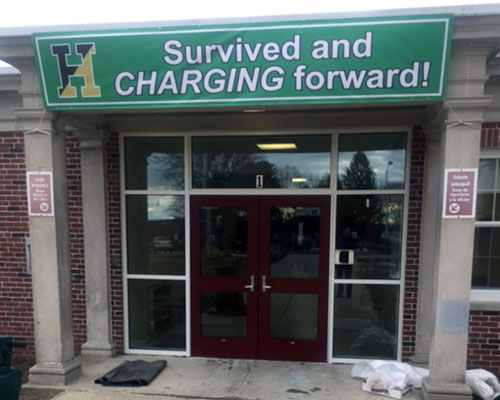Students at the Albert B. Consentino School were greeted by this banner, “Survived and Charging Forward,” upon returning to their damaged school this morning. (Courtesy photograph.)
Consentino Middle School and other Haverhill public schools, affected by frozen water pipe damage during last week’s cold spell, reopened Monday to students returning from February recess.
Work to restore the Consentino library from “massive damage” last week due to a burst heating pipe will continue during evening hours, according to Superintendent of Schools James F. Scully. In an e-mail message to parents and the school community Sunday afternoon, Scully said the Consentino “has been scrubbed and is ready to welcome students back.”
“Students, upon entering Monday, will see one corridor area with approximately 210 feet of exposed ceiling area where beams, concrete, conduit, and computer wiring are visible,” Scully said. “I am most grateful to all who have managed and worked around the clock to transform this unfortunate incident so that the children and staff at the Consentino and other schools can return to school safely Monday.”
Elsewhere, as WHAV reported last week, “not as extensive” water damage was reported as two sprinkler heads opened during the cold spell at Pentucket Lake School and another at the lobby of Haverhill High School’s Charles C. White Pool. Scully added the high school “had three locations, Pentucket two locations” where damage was contained by crews that were alerted by newer detection systems.
“The Consentino had three locations and the detection systems there are from a different era and thus not capable of detecting such changes with pressure or steam issues,” Scully said. Last Monday, Consentino Principal John Mele had discovered the damage to the library area, an adjacent elevator and a second-floor classroom where a pipe burst, according to Scully.
“Water poured into the school library and adjacent corridor causing the ceiling system to fail. Asbestos-containing sprayed-on fireproofing located above the ceiling in some areas was saturated, and there was a risk of contamination if it remained in place. In the second floor classroom where the leak occurred, asbestos-containing floor tiles delaminated from the concrete floor and were removed. The elevator system has suffered much damage and is still being assessed.,” Scully said.
“Despite the fact that all buildings had heating values turned up – the below normal freezing levels were extreme for some of our facilities. Had it not been for the efforts of many during that freezing period other issues would have surfaced,” Scully said.
Scully credited Mele as well as Supervisor of Facilities Tom Geary and others, including the Department of Environmental Protection, “who worked around the clock for seven days to allow the Consentino to reopen.” He added a team including an environmental firm and an asbestos abatement contractor followed “each and every safety protocol” mandated by state and federal laws “to the letter” to remove damaged and “potentially contaminated materials” safely.
“An emergency waiver was obtained from the Massachusetts Department of Environmental Protection to proceed with asbestos abatement immediately. This state agency made multiple site visits and were most helpful with this recovery effort. Asbestos removal activities and associated demolition work were performed inside a series of negative pressure containments by Massachusetts-licensed asbestos workers. Massachusetts-licensed Asbestos Project Monitors provided oversight during removal activities, and upon completion of removal, performed visual inspections and clearance air sampling in each containment. All air samples collected were found to be below federal and state clearance standards prior to the teardown of each containment.”

